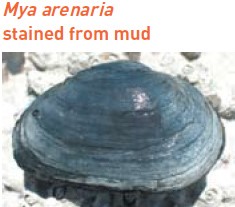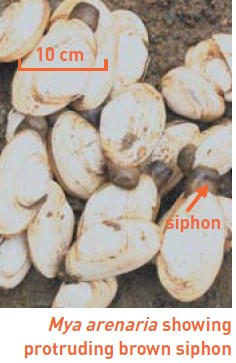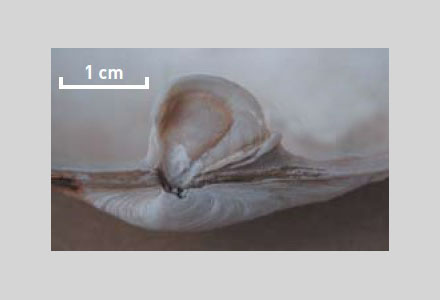Soft shell or long-necked clam (Mya arenaria and Mya japonica) compete with native clams for space. In large numbers their feeding can reduce food availability for oysters, mussels and scallops. They can change the characteristics of sediments and the composition of bottom-dwelling communities.
What to look for
Features:
- chalky white, rough shell
- shells may be discoloured in black or red mud
- different shells—one has a large scooped-out projection and the other a pit
- gapes at both ends when closed
- thin and oval
- uneven growth lines
- up to 15cm.



Where to look
Look in or around:
- gravel
- mud
- sand.
Likely habitats include:
- shores and shallow areas.
Similar native species
These native species look similar to Soft shell or long-necked clam. They do not need to be reported.
Gaper clam (Lutraria rhynchaena)
Features:
- off-white, often covered with a brown skin
- solid elongated shell
- gapes when shut
- fine evenly spaced (concentric) ridges
- up to 12cm.
Habitat:
- mud
- sand
- sheltered shores.
Known locations are New South Wales, Victoria, Tasmania, South Australia and southern Western Australia.
Venus cockle (Venerupis galactites)
Features:
- solid white shell
- identical valves that close completely
- no scooped-out projection
- up to 5cm.
Habitat:
- bays, estuaries and sheltered coasts
- sandy shores.
Known locations are New South Wales, Victoria, Tasmania, South Australia and southern Western Australia.
Lantern/gaper shell (Laternula recta/rostrata)
Features:
- white
- elongated shell, gapes at both ends when closed
- fine, evenly spaced (concentric) ridges
- up to 6cm.
Habitat:
- mud
- sand.
Known locations are New South Wales, Victoria, and South Australia.
Report it
See something unusual? Report it. Even if you’re not sure.
If you see something you think is a pest:
- note the exact location (screenshot your map app or enable photo geotagging on your phone)
- take a photo (use something for size reference, like a coin or note)
- contact your state or territory authority.
Stop the spread of marine pests
Start with these simple steps:
- Inspect and clean your boat or yacht. Make sure you check hard to reach areas.
- Treat the hull of your boat or yacht regularly.
- Clean and dry your fishing and diving gear after every use.
How you can stop the spread of marine pests.
Your location
The map shows known pests and pests to look for around Australia.





